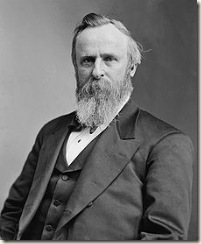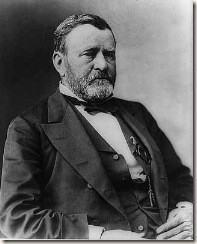The Hayes presidency occurred at a critical time in American history. This was during the reconstruction period following the civil war. It was during his administration that military occupation ended and self rule were returned to the former rebellious states.
Rutherford Birchard Hayes (1822-1893) was born and raised in Ohio. His father died before Rutherford was born, so his uncle Sardis helped raise him and became a father figure. After attending law school at Harvard, Hayes returned to Ohio to practice law. He started practicing law in a town called Lower Sandusky (now Fremont). Business was slow at the beginning, but he was able to represent his uncle Sardis on some real estate litigation. In 1850 he decided to move to Cincinnati and opened a law practice with John Herron. Due to the fact that Cincinnati was just across the river from Kentucky, many of his legal cases involved runaway slaves. Hayes defended several such cases due to his strong abolitionist views (probably strengthened by his recent courting of Lucy Webb, who was firmly against slavery and drinking). His work defending fugitive slaves also brought him to the attention of the newly formed Republican Party. The city solicitor of Cincinnati was Hayes’ first elected office in 1859.
With the start of the Civil War, Hayes put his law practice on hold and joined the 23rd Regiment of Ohio Volunteer Infantry as a major. Notable within his unit was a young private, William McKinley, who would also become president; Stanley Matthews, who went on to become a U.S. Senator and Supreme Court Justice; and future Congressman Joseph Kennedy.
Hayes was wounded five times during the Civil War leading his troops into battle. He served with distinction and became a legend back in Ohio as stories of his heroism found trickled back home. By the end of the war Hayes had been promoted to brigadier general. In 1864 while still in the field, he was nominated and won a seat in the United States Congress without once campaigning.
During his first term as a U.S. Congressman, Hayes identified with the more moderate wing of the Republican party, but was willing to vote with the radicals. He agreed with the Republican view that the southern states should be restored to the Union, but not without laws protecting the recently freed slaves. During his second term, he was the chairman of a committee on the Library of Congress. He secured funding from the congress to expand the library’s science collection.
Hayes returned to Ohio after two terms in the House of Representatives to run for, and win, election to the governor’s seat. During his first term he was fairly restricted on what he could accomplish because the legislature was controlled by the Democrats and the Governor of Ohio had no veto power. In spite of these restrictions he was able to establish a reform school for girls and a school for deaf-mutes. Education was becoming a cornerstone of Hayes beliefs and something he would pursue long after his presidency. During his second term the Republicans took control of the legislature. This control allowed Ohio to pass the Fifteenth Amendment to the U.S. Constitution which guaranteed the right to vote to all Americans regardless of race or color.
In 1872 Hayes left the governor’s seat and retired to private life. In this time his uncle Sardis Birchard died, leaving him Hayes his home, Spiegel Mansion, and his substantial wealth. His retirement didn’t last too long and he was elected to a third term as Governor of Ohio in 1875.
The presidential election of 1876, the year of the centennial of the Declaration of Independence, is one of the most well-known elections in American Presidential history. It is famous because it was tainted with allegations of fraud, voter intimidation and a stolen election (no this is not 2000). Hayes was running against Samuel Tilden from New York. Three days after the election Tilden was leading Hayes by an electoral vote of 184-165. There were still 20 outstanding electoral votes in dispute in Oregon, South Carolina, Louisiana and, yes, Florida. Ultimately a congressional commission comprised of fifteen members (7 Republicans, 7 Democrats and 1 Independent) representing the House (5), Senate (5) and the Supreme Court (5) were charged with deciding the disputed votes. Obviously it was decided in favor of Hayes, but only after a compromise that promised Hayes would withdraw federal troops from the southern states, accept the election of Democratic governments in the south, the appointment of a southern Democrat to Hayes’ cabinet and funding for the Texas and Pacific railroad.
There were several major issues that Hayes had to deal with during his single term. Two of them were the removal of military rule in the remaining southern states and that his resolve to deal with the issue of patronage. In dealing with patronage, he was striking at the heart of power for many people. Since the time of Jackson, politicians and political bosses got to select people for certain roles. In one particular case Hayes effectively fired the Collector of the Port of New York through an Executive Order. The Collector of the Port of New York, as it would happen, was future president Chester A. Arthur. This was a very lucrative position because he earned a percentage of the goods that passed through the port. I’ll cover the patronage issue further in my entry on Arthur.
During his first year in office the largest labor dispute to date occurred in the form of the Great Railroad Strike of 1877. At issue were wages for the workers. In order to make up for financial losses that the owners incurred during the Panic of 1873 they started cutting the employees’ salaries. Workers started striking in West Virginia and spread throughout the East and Midwest. Hayes sent in the military on multiple occasions at the request of governors to quell the outbreaks. In each case, the rioting ended before the troops were engaged. No rioters were killed by the military, but it was the first time that federal troops were sent in to break up a strike against a private company.
Hayes was dedicated to the principal of equal rights for all, regardless of color or race, and felt that the best way to bring up the disenfranchised through was through education.
After his presidency, Hayes remained active in the issues that he felt were important. He continuously worked to improve veterans’ organizations and served on boards associated with education.
Hayes Trivia
- As a young man, Hayes fought lyssophobia, or the fear of going insane
- First Lady Lucy Hayes got the nickname Lemonade Lucy for banning alcohol from the White House.
- Hayes is one of only two presidents (T. Roosevelt) whose son won the Congressional Medal of Honor. Major Webb Hayes won the Congressional Medal of Honor during the Spanish American War.
- Hayes is one of four presidents that did not win the popular vote: J. Q. Adams, Hayes, B. Harrison, G. W. Bush.
- During his second term as Governor of Ohio, Hayes oversaw the establishment of a state Agricultural and Mechanical College. This later became Ohio State University. I won’t hold this against him.
- Because March 4, 1877 fell on a Sunday, Hayes took the oath of office privately on Saturday, March 3, in the Red Room of the White House. He took the oath publicly on the following Monday.
- Hayes was the first president to talk on a telephone in a call to Alexander Graham Bell. His response to the experience was “That’s an amazing invention, but who would ever want to use one of them?” It’s a good thing he didn’t live to see Twitter!
- After his disputed election Hayes started receiving death threats. He was encouraged to go to Washington DC in secret. Hayes refused and rode into town in an open carriage. He did allow six special government agents to accompany him. It was the first time that the “secret service” protected the president.
- In spite of the compromise many Democrats referred to Hayes as Rutherfraud.
Vital Stats:
- Wife: Lucy Ware Webb (1831-1889, m. 1852)
- Children: Sardis Birchard Austin (1853-1926), James Webb Cook (1856-1935), Rutherford Platt (1858-1927), Joseph Thompson (1861-1863), George Crook (1864-1866), Frances (Franny) (1867-1950), Scott Russell (1871-1923), Manning Force (1873-1874)
- Party affiliation: Republican Party
- Presidency: 1876-1880
- Born: Oct 4th, 1822 (Delaware, Ohio)
- Died: Jan 16th, 1893 (Fremont, Ohio)

